Rustic Scandinavian design masterfully combines the simplicity and functionality of Nordic aesthetics with the warmth and ruggedness of rustic charm. This fusion creates living spaces that feel both clean and incredibly cozy, emphasizing natural materials, neutral color palettes, and a deep connection to the outdoors. The style, often associated with the Danish concept of "hygge," is all about crafting a comfortable, inviting atmosphere where you can relax and unwind. It’s a perfect balance between minimalist principles and the raw, unrefined beauty of nature, resulting in a timeless and serene living environment that feels both modern and grounded.
1. Exposed Wooden Beams in a Rustic Scandinavian Living Room

Exposed wooden beams instantly introduce a powerful architectural element that defines the rustic half of this design fusion. These structural features, whether original to the home or added for aesthetic appeal, bring a sense of history and organic texture to the clean lines of Scandinavian decor. Leaving the wood in its natural, unstained state or applying a light wash enhances its grain and imperfections, adding character and warmth. Paired with white walls and minimalist furniture, the beams create a stunning contrast, drawing the eye upward and making the space feel both grander and more intimate, perfectly embodying the cozy Scandi-rustic vibe.
2. A Raw Stone Fireplace in a Rustic Scandinavian Living Room

For the ultimate cozy focal point, a raw stone fireplace anchors a rustic Scandinavian living room with its earthy presence and comforting warmth. Unlike sleek, modern designs, a fireplace constructed from rugged, uneven stones provides a textural counterpoint to the smooth surfaces and clean lines typical of Nordic interiors. This feature becomes the heart of the home, a natural gathering spot that radiates hygge. The cool tones of the stone complement a neutral color palette of whites, grays, and beiges, while the dancing flames add a dynamic, warm light that enhances the room’s inviting and serene atmosphere.
3. Light-Washed Wood Flooring for a Rustic Scandinavian Living Room

Light-washed or pale wood flooring is a quintessential element for achieving a bright and airy rustic Scandinavian living room. This choice of flooring reflects natural light, making the entire space feel larger and more open, a core principle of Nordic design. Opting for wide planks with visible grain and knots adds the rustic texture needed to ground the room and prevent it from feeling too sterile. The soft, muted tones of the wood provide a perfect neutral canvas for layering cozy rugs, minimalist furniture, and natural decor elements, creating a cohesive look that is both sophisticated and wonderfully down-to-earth.
4. Neutral Color Palette with Earthy Accents in a Rustic Scandinavian Living Room
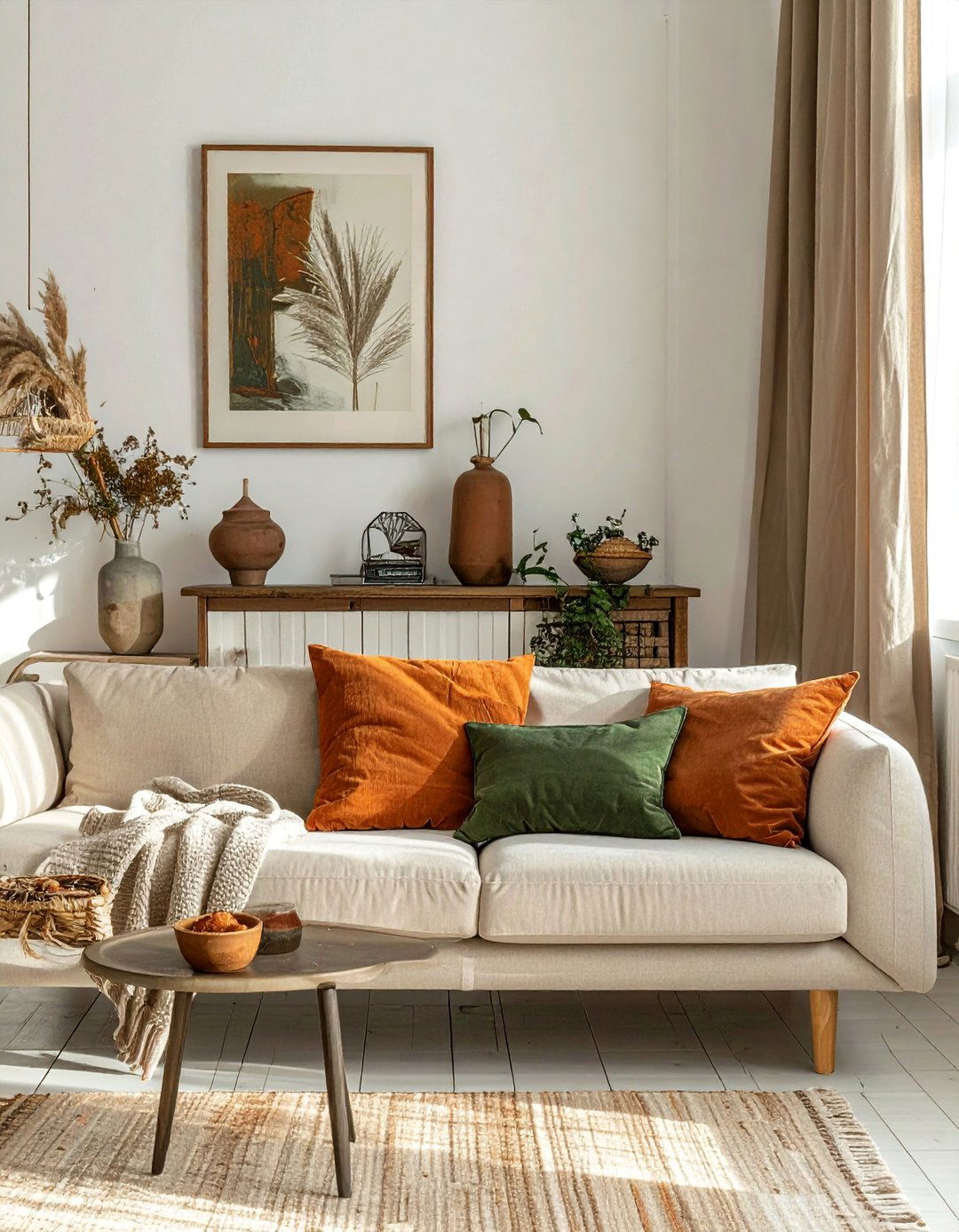
A foundational aspect of this style is a predominantly neutral color palette that promotes a sense of calm and simplicity. Walls painted in soft whites, light grays, or muted beiges create a serene backdrop that maximizes natural light. To introduce rustic warmth, this clean canvas is punctuated with earthy accents. Think throw pillows in deep olive green, a cozy blanket in a rich terracotta hue, or ceramic decor in shades of clay and sand. These subtle yet impactful additions of color connect the indoor space to the natural world, enhancing the cozy, grounded feeling of the room without overwhelming its minimalist foundation.
5. Minimalist Furniture with Natural Wood Finishes in a Rustic Scandinavian Living Room
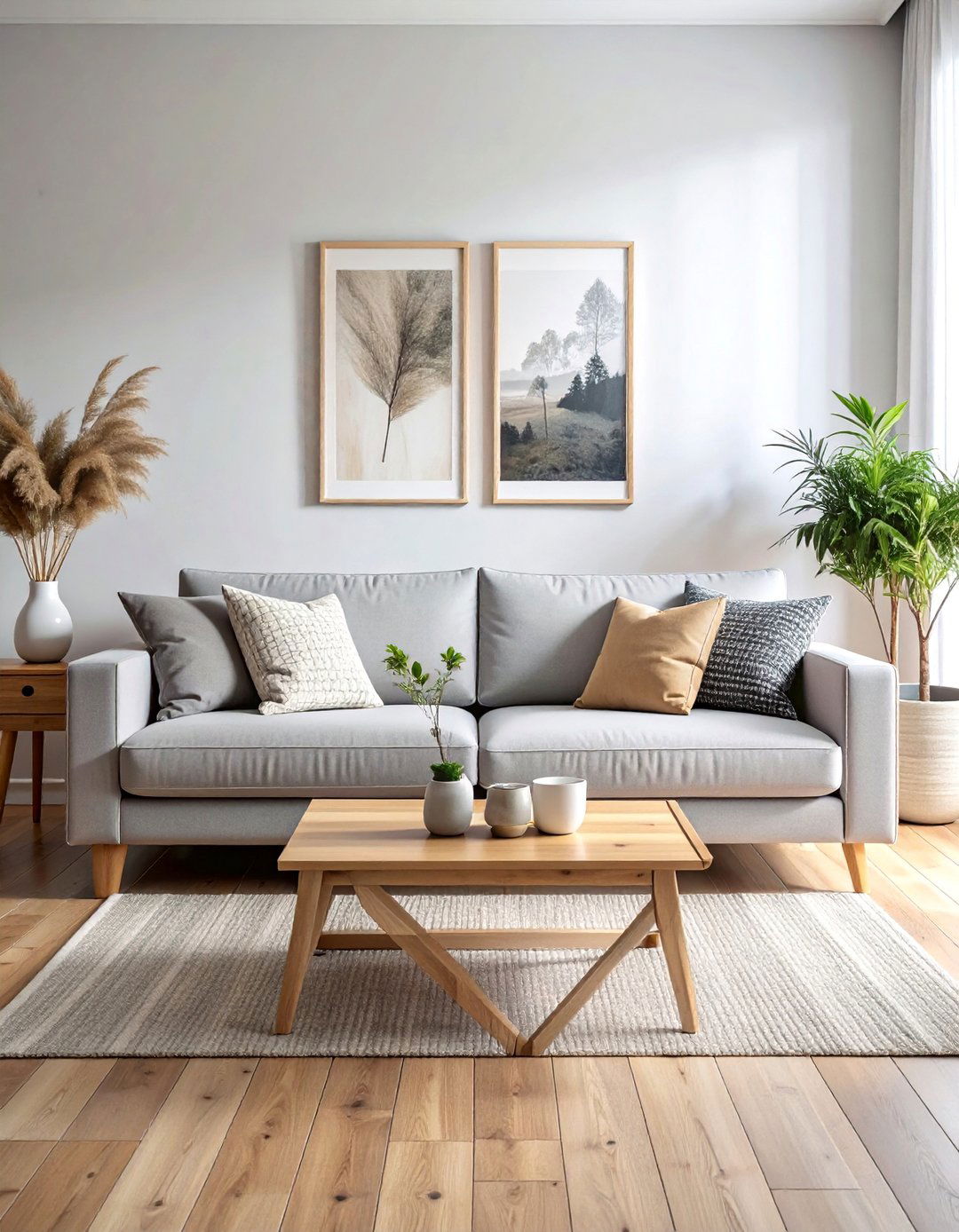
Furniture in a rustic Scandinavian living room prioritizes clean lines, simple forms, and functionality, yet it avoids feeling cold by embracing natural materials. Look for sofas with simple silhouettes upholstered in neutral fabrics, paired with coffee tables and sideboards made from solid, light-toned wood like oak, ash, or pine. The key is to celebrate the wood's natural grain, knots, and imperfections, which adds the rustic character. This approach ensures that each piece is not only practical but also serves as a subtle nod to nature, contributing to the room’s overall sense of warmth, authenticity, and uncluttered calm.
6. Large Unadorned Windows to Maximize Natural Light
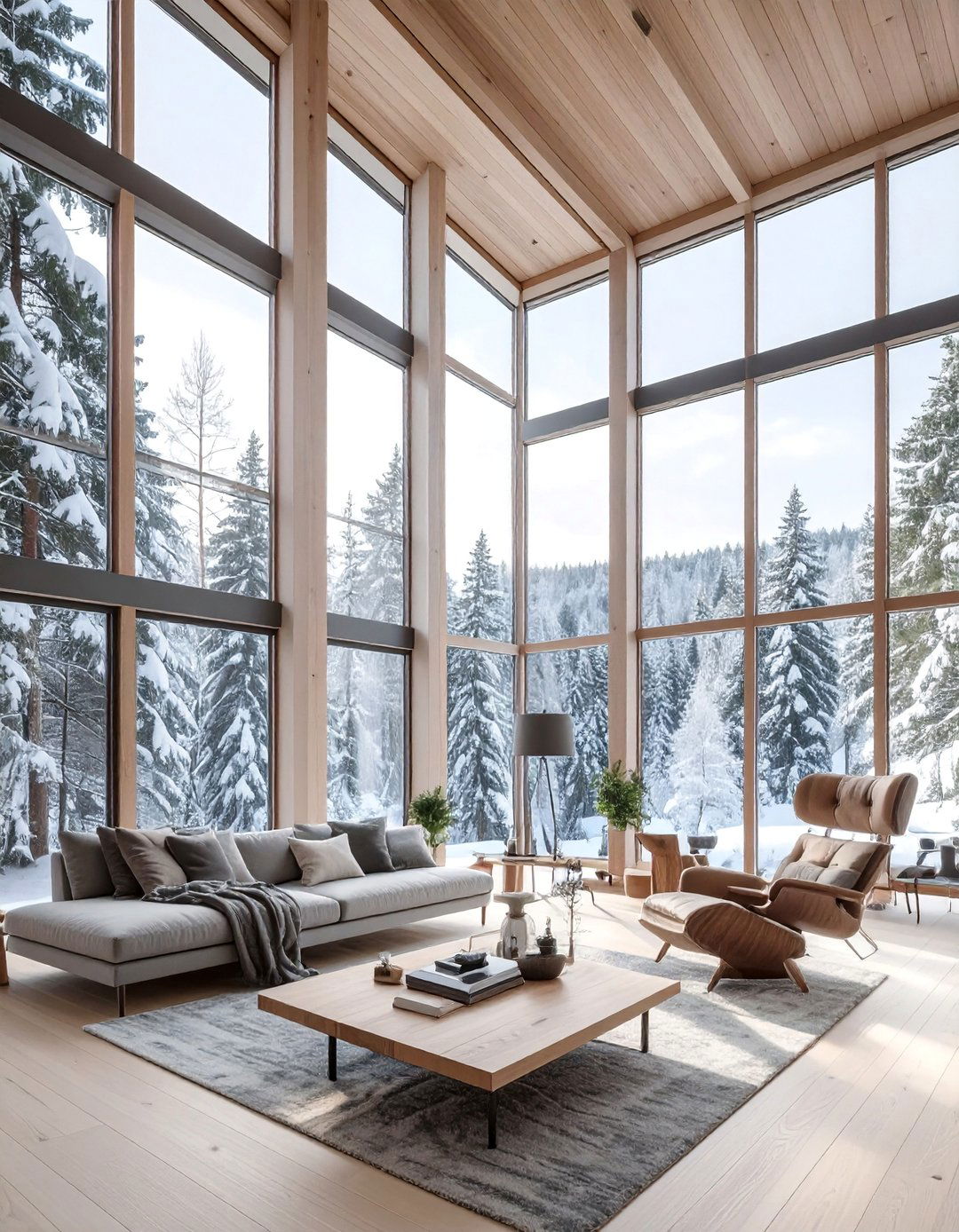
Maximizing natural light is a cornerstone of Scandinavian design, born from the need to brighten homes during long, dark winters. In a rustic Scandinavian living room, large, unadorned windows are essential for creating a bright, airy, and uplifting atmosphere. Forgoing heavy curtains in favor of simple, sheer linen drapes or leaving the windows bare allows sunlight to stream in freely, illuminating the natural textures of wood and stone within the space. This connection to the outdoors not only brightens the room but also enhances the sense of tranquility and reinforces the design’s emphasis on nature and simplicity.
7. Layering Textures with Chunky Knit Throws and Sheepskin Rugs
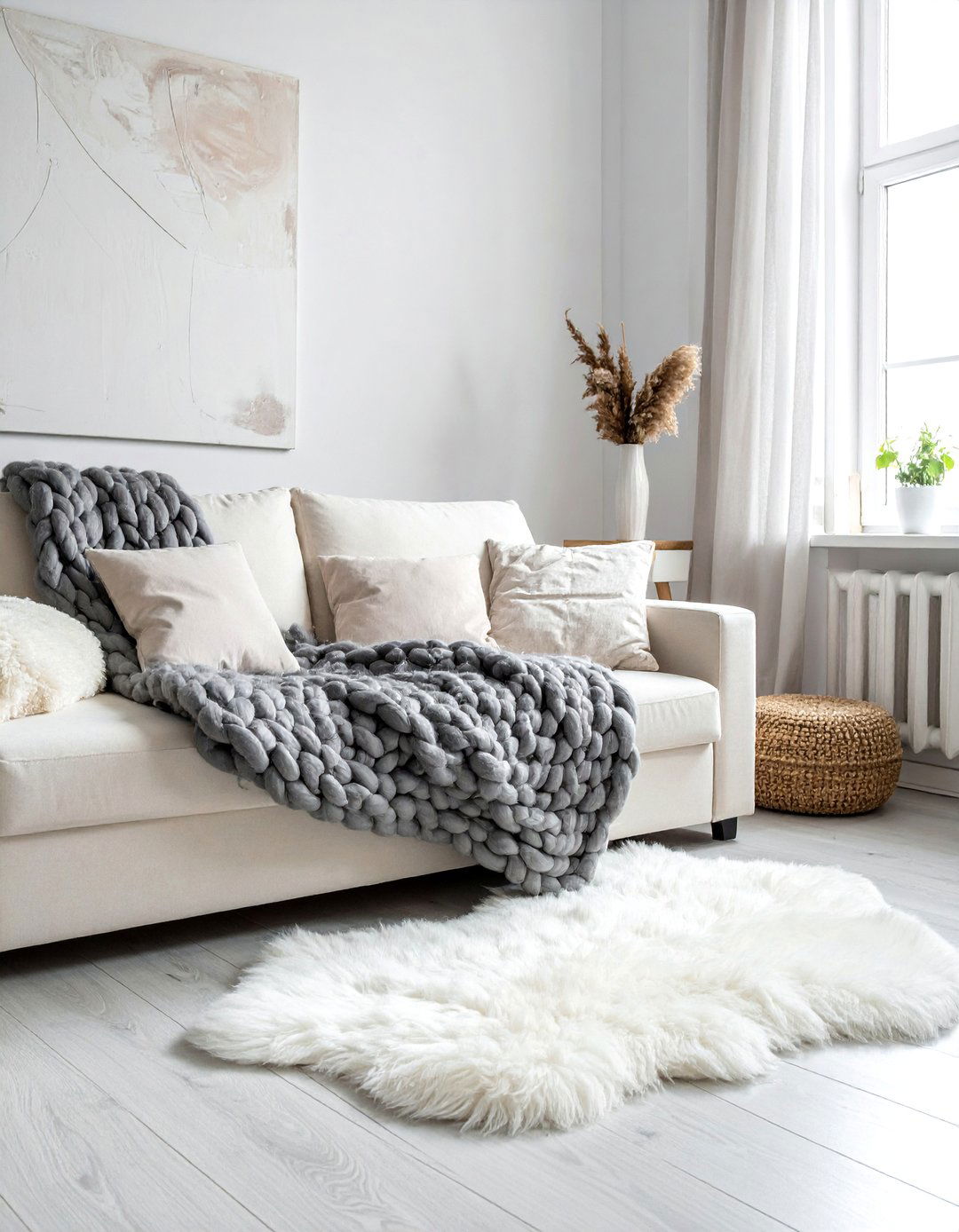
To cultivate a cozy, hygge-inspired vibe, layering a variety of textures is crucial in a rustic Scandinavian living room. Drape a chunky knit wool throw over the arm of a streamlined sofa to add visual weight and irresistible softness. Place a plush, natural sheepskin rug on the light wood floor or over an armchair to introduce a touch of organic luxury and warmth underfoot. These tactile elements contrast beautifully with the smooth surfaces of wooden furniture and the clean lines of the decor, creating a space that feels rich, inviting, and deeply comfortable without adding unnecessary clutter.
8. Incorporating Natural Greenery and Houseplants

Bringing the outdoors in is fundamental to the rustic Scandinavian aesthetic, and incorporating an abundance of natural greenery is the easiest way to achieve this. Strategically placed houseplants, from a tall fiddle-leaf fig in a corner to a collection of succulents on a windowsill, add life, color, and an organic element to the space. The vibrant green of the leaves provides a refreshing contrast against the neutral color palette. Potted in simple terracotta or ceramic planters, these plants not only purify the air but also enhance the room’s connection to nature, fostering a serene and calming environment.
9. Using Worn Leather Accents for a Touch of Warmth
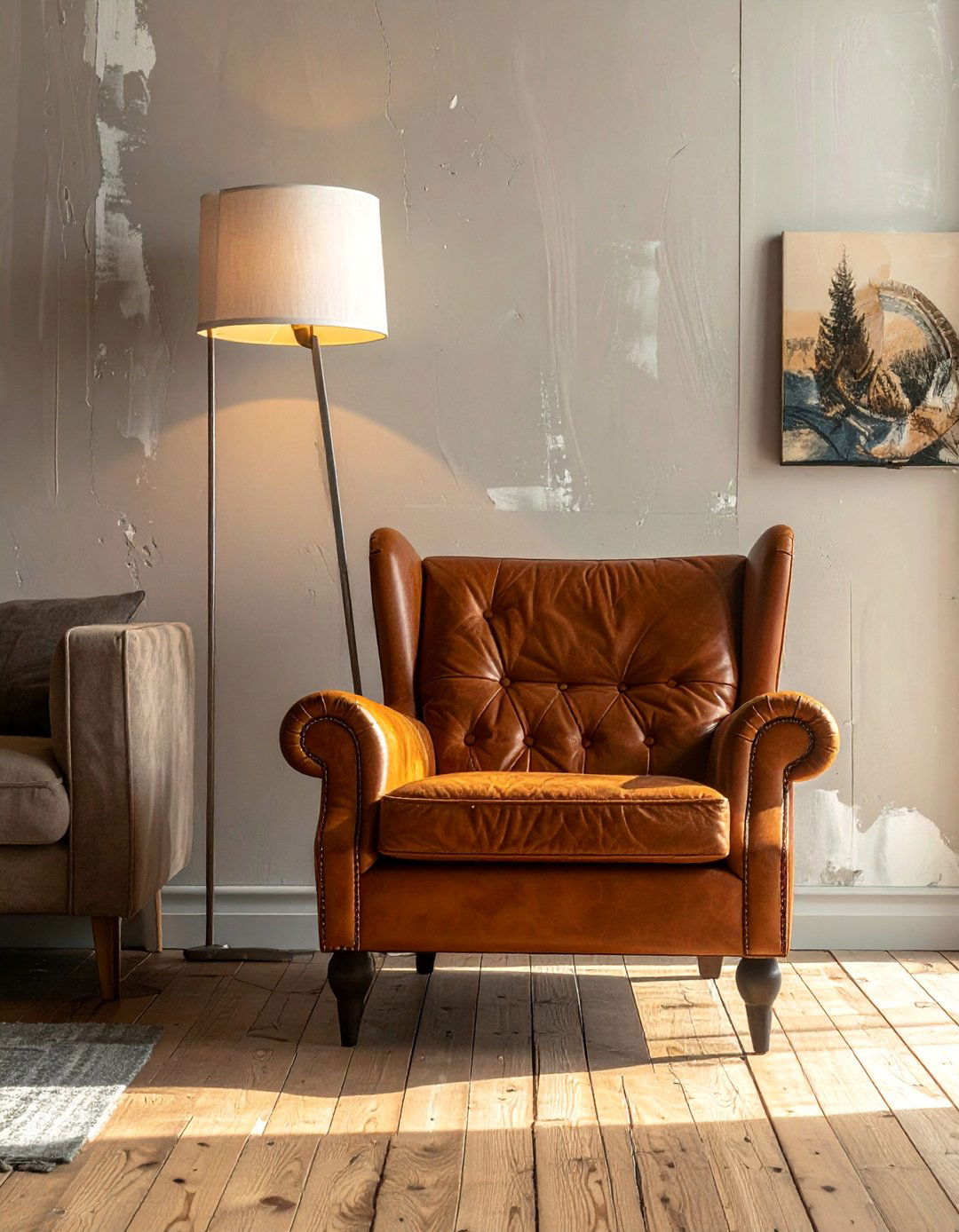
Worn leather accents introduce a sophisticated yet rugged element to a rustic Scandinavian living room. A cognac or caramel-colored leather armchair, with its natural patina and soft texture, can serve as a stunning statement piece that exudes timeless warmth. Alternatively, smaller touches like leather throw pillows on a fabric sofa or a leather-handled tray on a coffee table can provide a similar effect. The rich, warm tones of the leather contrast beautifully with the cool, neutral palette and light woods, adding a layer of depth and character that feels both comfortable and effortlessly stylish.
10. A Gallery Wall of Nature-Inspired Art
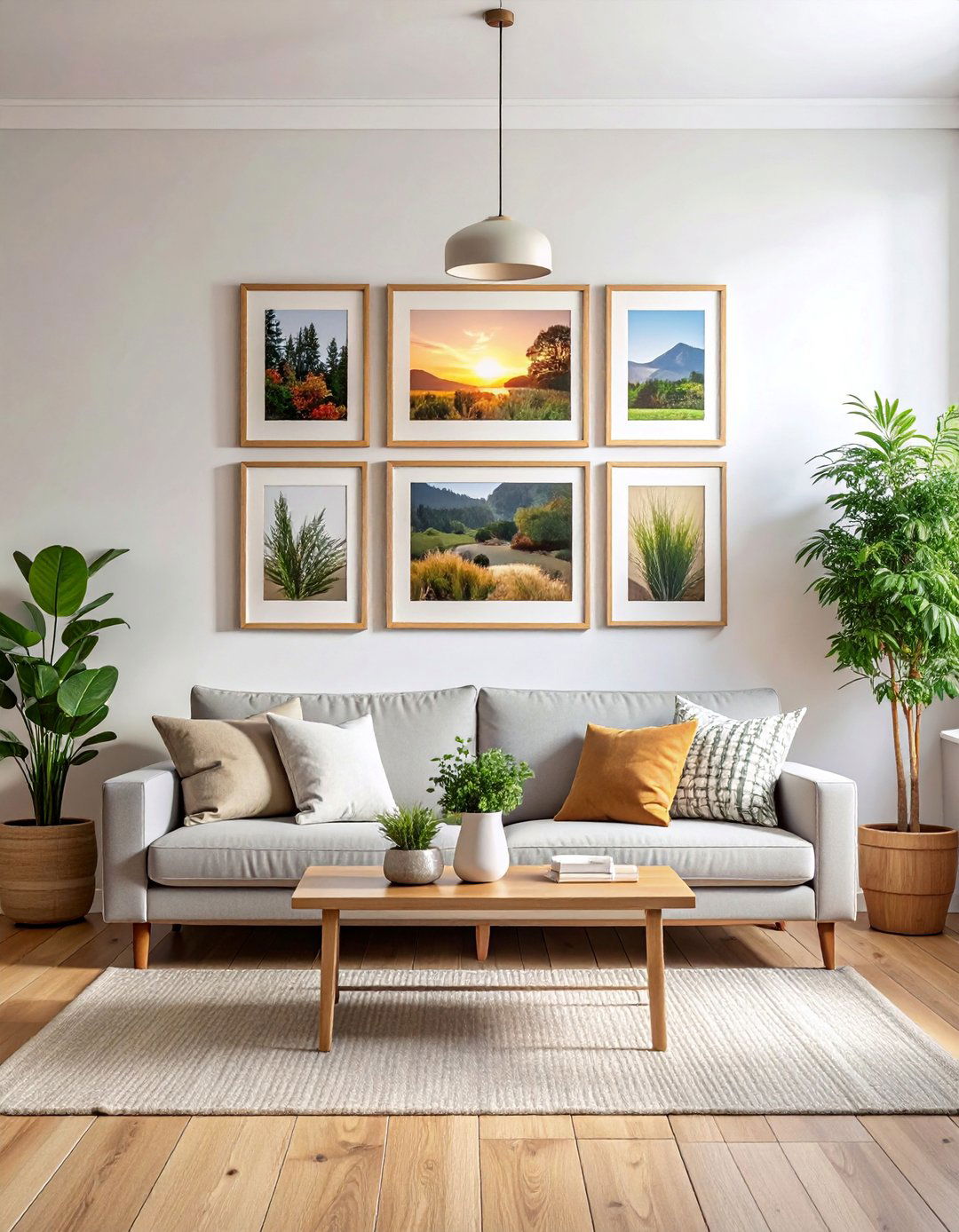
A carefully curated gallery wall featuring nature-inspired art can personalize a rustic Scandinavian living room while reinforcing its core theme. Select a collection of prints and photographs depicting serene landscapes, botanical illustrations, or abstract forms found in nature. Frame them in simple, light wood or black frames of varying sizes to maintain a clean, uncluttered look. Arranging them asymmetrically above a sofa or console table adds visual interest and a personal touch. This artistic element brings the beauty of the outdoors inside, complementing the natural materials and enhancing the room's tranquil, earthy ambiance.
11. Clustered Pendant Lighting with Natural Shades

Lighting plays a critical role in setting the mood, and clustered pendant lights with natural shades are a perfect fit for a rustic Scandinavian living room. Grouping several pendants at varying heights over a seating area or coffee table creates a captivating focal point and provides warm, ambient illumination. Choose shades made from materials like woven rattan, bamboo, or light-colored linen to add texture and an organic touch. This style of lighting not only enhances the cozy, hygge atmosphere after dark but also serves as a beautiful decorative element during the day, aligning perfectly with the aesthetic's love for natural, simple forms.
12. Utilizing Vintage Wooden Crates for Storage
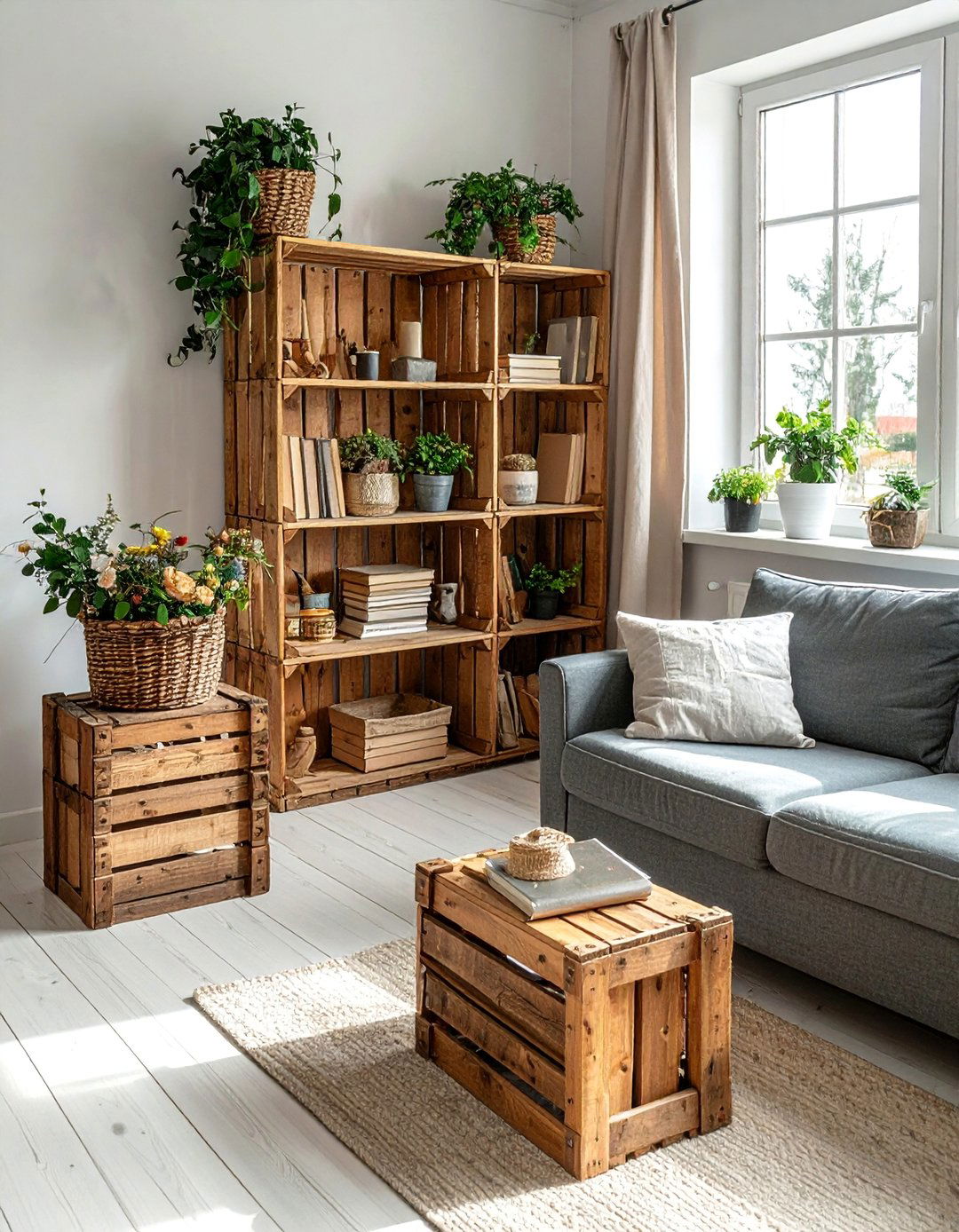
For a touch of authentic rustic charm, incorporate vintage wooden crates as a practical and stylish storage solution. An old apple or wine crate can be turned on its side to function as a unique end table with a built-in shelf for books or magazines. Stack a few crates together to create a rustic, modular shelving unit for displaying plants, photos, and other decorative objects. The aged wood, often bearing original stamps or markings, adds a sense of history and character that beautifully complements the clean, modern lines of Scandinavian furniture, perfectly blending old with new in a functional way.
13. A Foraged Branches Display in a Simple Vase
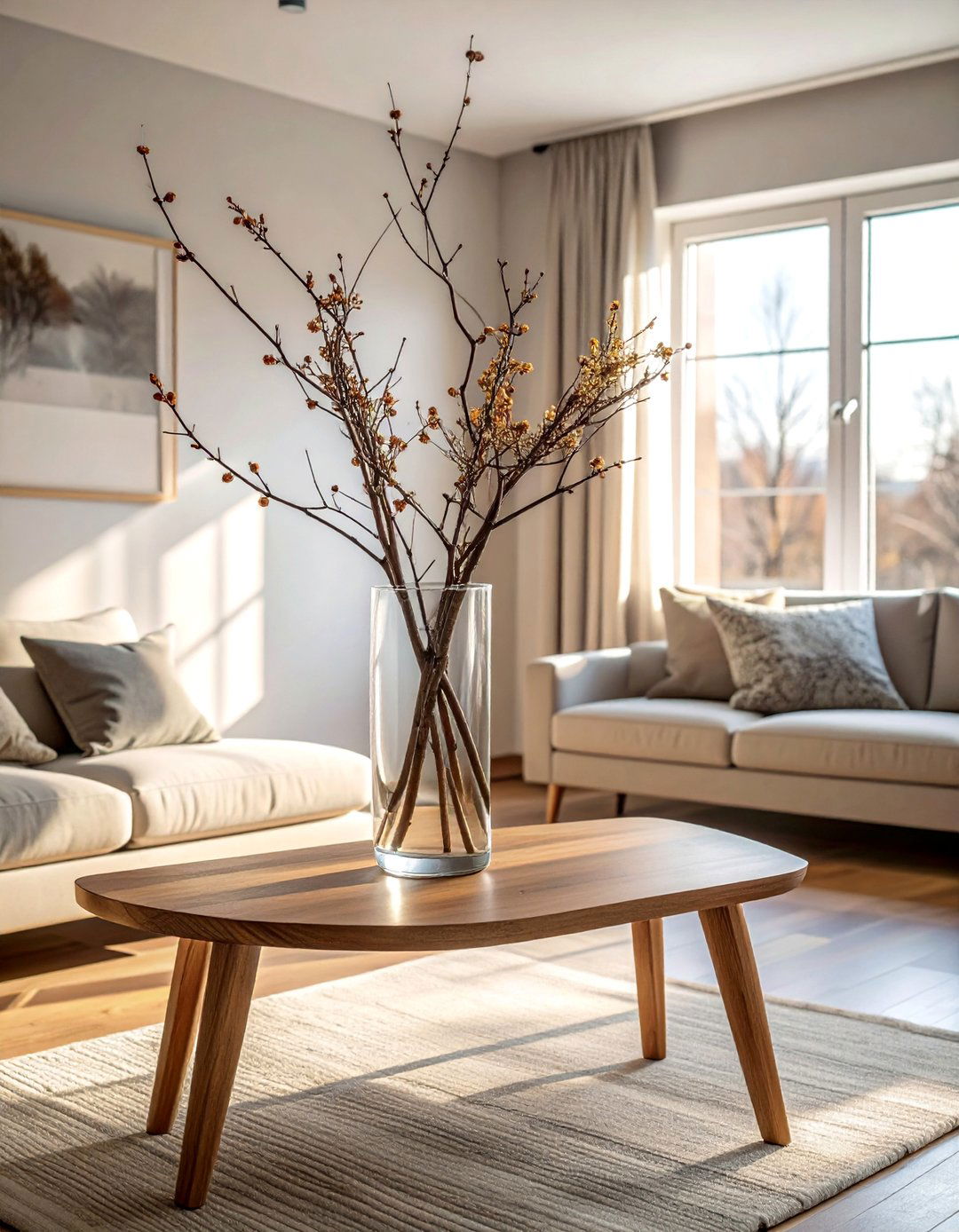
One of the simplest yet most impactful decor ideas is to display foraged branches in a minimalist vase. This practice directly channels the Scandinavian appreciation for nature and seasonal beauty. In the autumn, gather branches with colorful leaves; in winter, bare, sculptural branches make a striking statement. Placed in a simple ceramic or clear glass vase on a console table, mantel, or coffee table, this arrangement adds height, organic texture, and a touch of wildness to the room. It’s an effortless and cost-effective way to bring a piece of the outdoors inside, creating a living art piece that changes with the seasons.
14. A Simple Linen-Upholstered Sofa
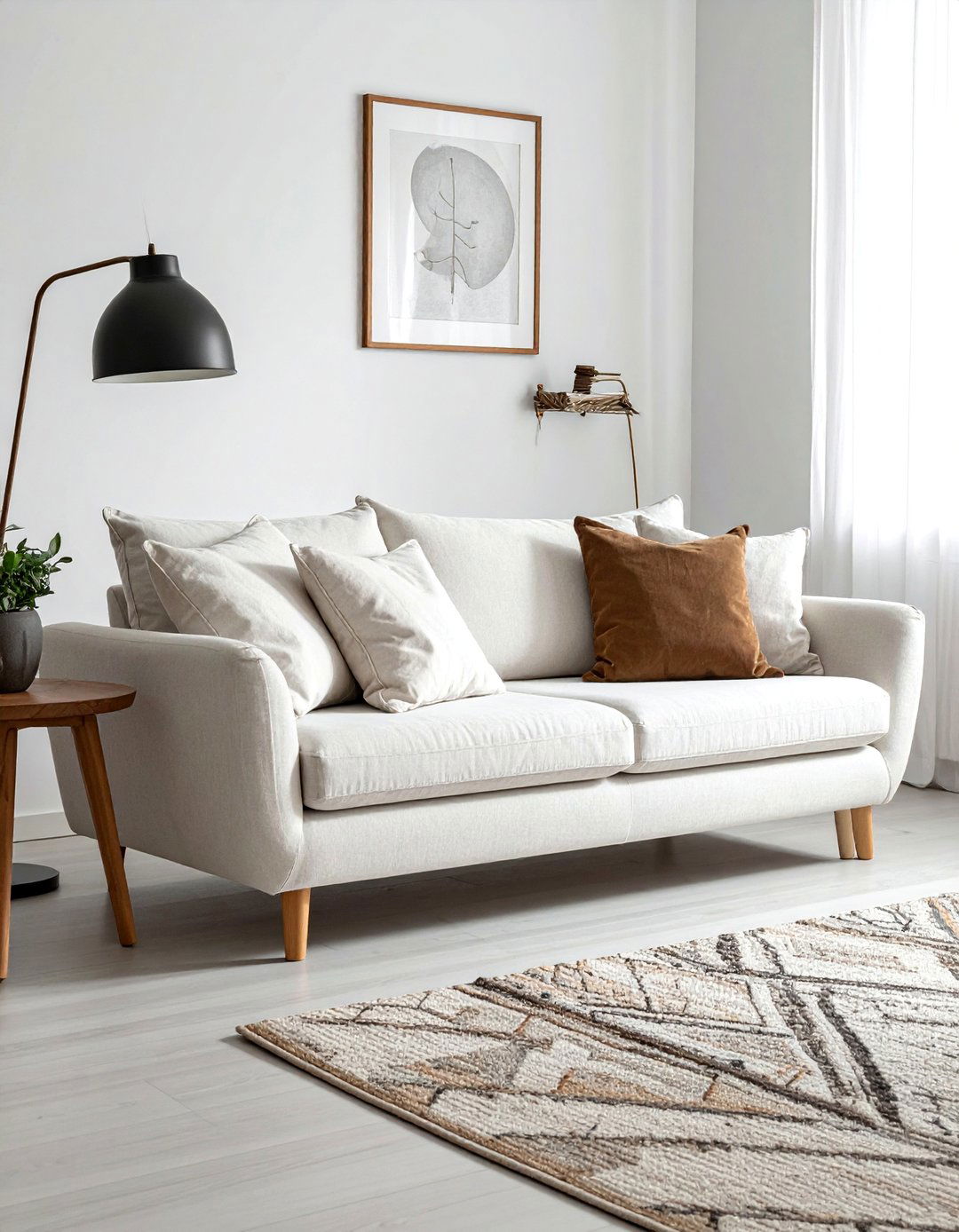
The centerpiece of any living room, the sofa, should embody comfort and simplicity in a rustic Scandinavian design. A sofa upholstered in a natural, textured fabric like linen is an ideal choice. Opt for a neutral color such as off-white, beige, or a soft gray to maintain a light and airy feel. The relaxed, slightly rumpled look of linen adds a touch of casual, rustic elegance that prevents the minimalist form from feeling too rigid. This choice provides a comfortable, inviting foundation for the room, perfect for layering with cozy pillows and throws to create the ultimate hygge-inspired seating area.
15. A Reclaimed Wood Coffee Table
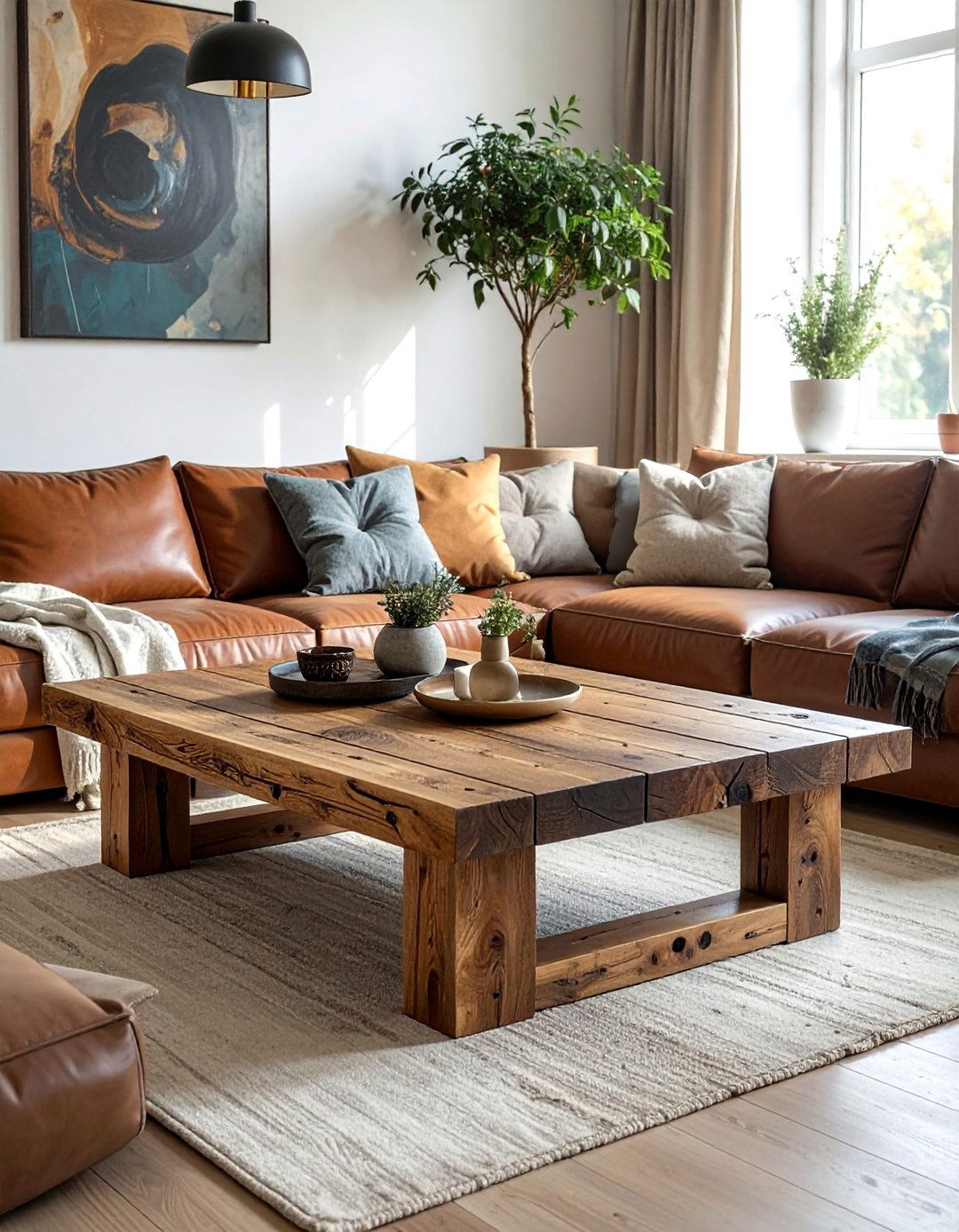
A reclaimed wood coffee table serves as a perfect rustic anchor in an otherwise minimalist Scandinavian living room. The wood's history—visible in its nail holes, saw marks, and unique grain patterns—tells a story and introduces an unmatched level of character and authenticity. Whether it's a chunky, solid block design or a more refined piece with simple metal legs, a reclaimed wood coffee table provides a robust, earthy focal point. Its textured surface is ideal for grounding the seating area and offers a beautiful contrast to softer elements like a fabric sofa or plush rug, perfectly balancing rustic charm with modern simplicity.
16. Woven Baskets for Stylish Storage

Woven baskets made from natural fibers like jute, seagrass, or water hyacinth are an essential accessory in a rustic Scandinavian living room. These versatile pieces offer a stylish solution for concealing clutter while adding significant textural interest. Use a large basket to store extra blankets and pillows next to the sofa, or place smaller ones on shelves to organize magazines, remotes, or children’s toys. The warm, earthy tones and handcrafted feel of the baskets enhance the room's connection to nature and contribute to its relaxed, cozy atmosphere, proving that practical storage can also be beautifully decorative.
17. Simple Floating Shelves Made of Raw Wood
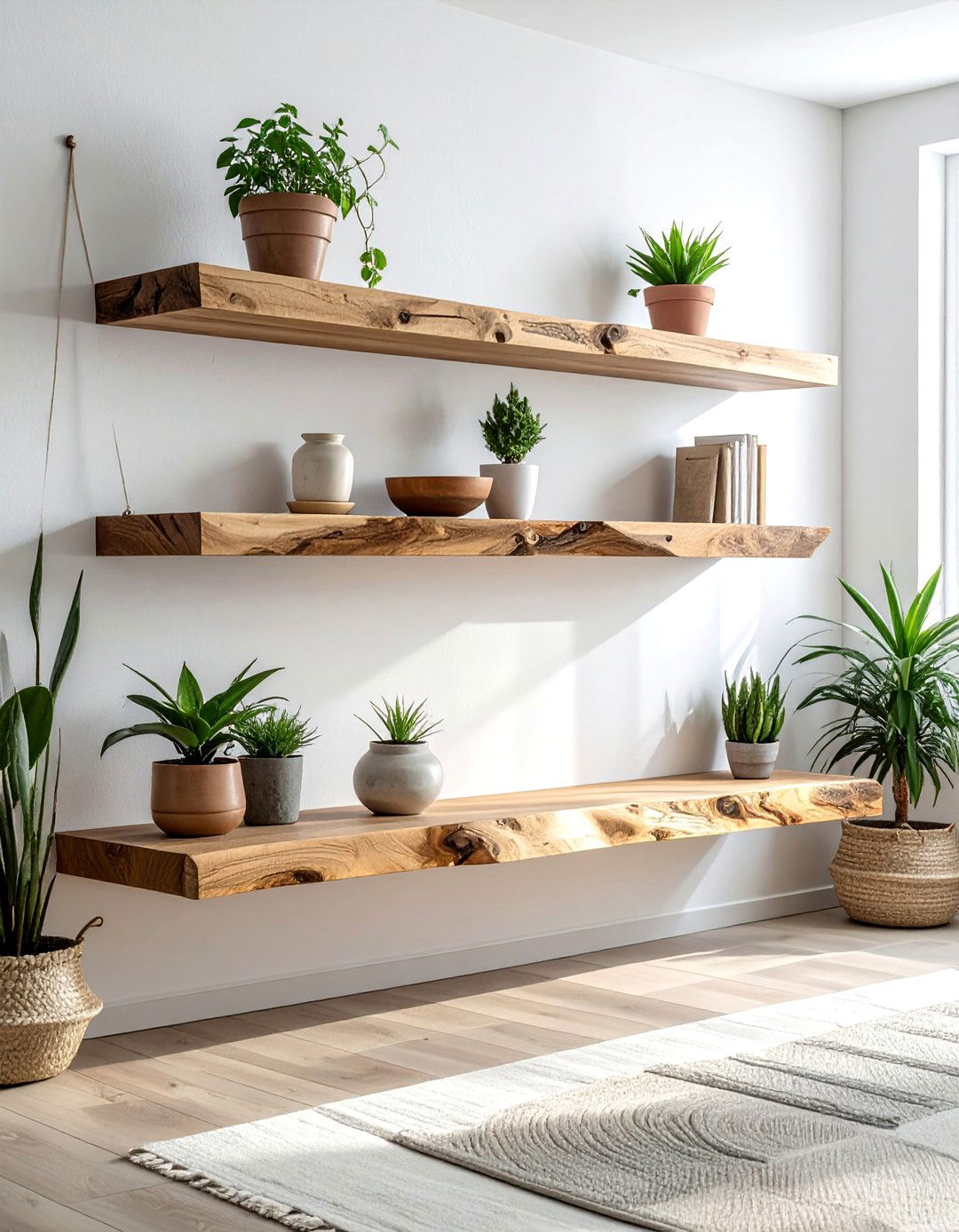
To display decor without adding bulky furniture, install simple floating shelves made of raw, unfinished wood. These shelves offer a minimalist and functional way to showcase cherished items like small plants, ceramic vases, framed photos, or a curated collection of books. The raw edge and visible grain of the wood add a distinct rustic touch against a clean white or light gray wall. Mounting them above a console table or on either side of a window creates a sense of balance and provides a perfect platform for adding personal, decorative layers to the room while maintaining an uncluttered and airy feel.
18. A Muted-Pattern Area Rug
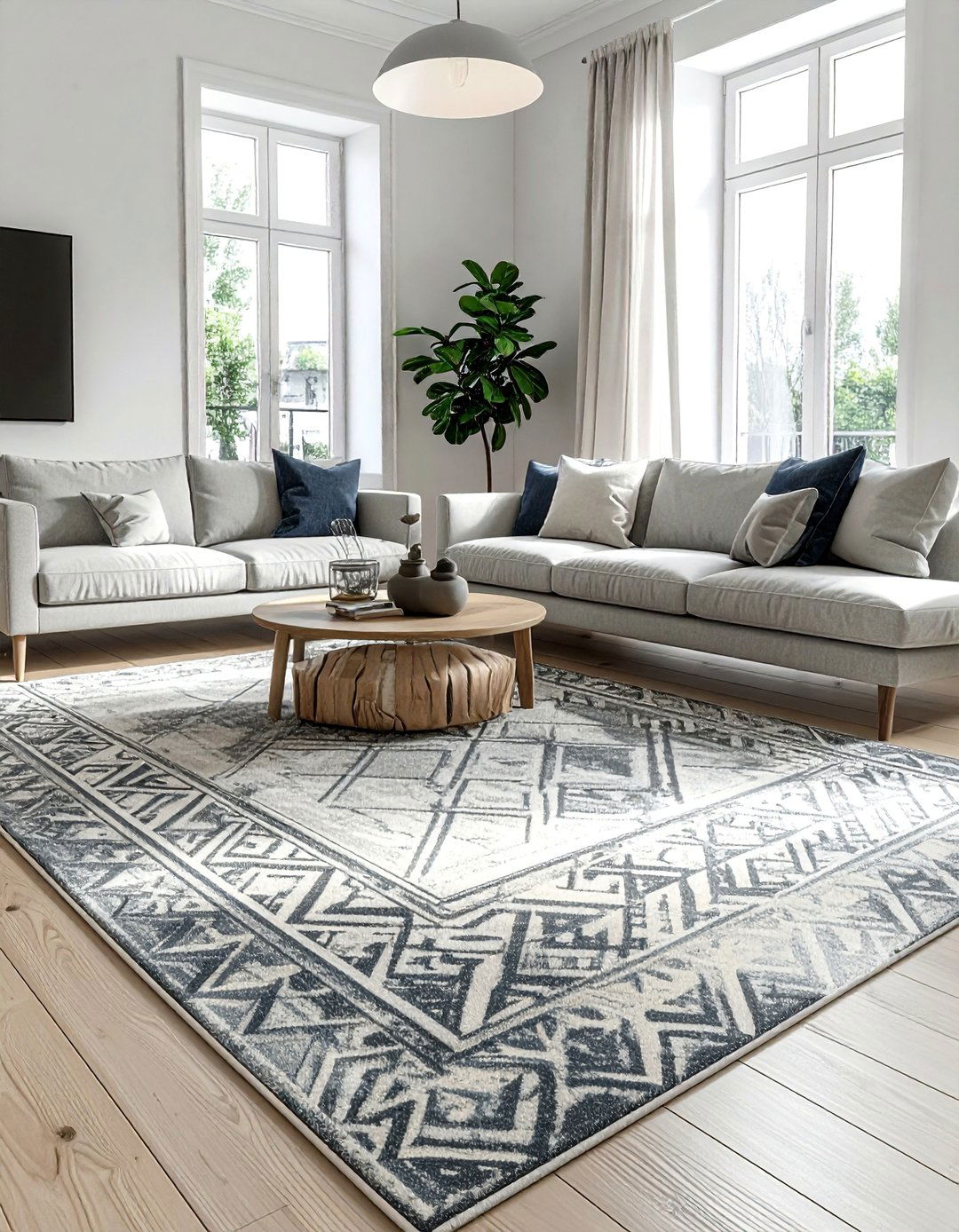
While Scandinavian design often favors simplicity, a muted-pattern area rug can add warmth, texture, and a subtle layer of visual interest to the living room floor. Choose a rug with a simple geometric pattern, such as faint stripes, diamonds, or a faded tribal design, in a neutral color palette of cream, gray, and charcoal. This element helps to define the seating area and adds a soft, cozy layer underfoot, breaking up the expanse of wood flooring. The subtle pattern introduces a touch of personality and artistic flair without disrupting the room's overall sense of calm and minimalist harmony.
19. Using Candles and Lanterns for Ambient Lighting
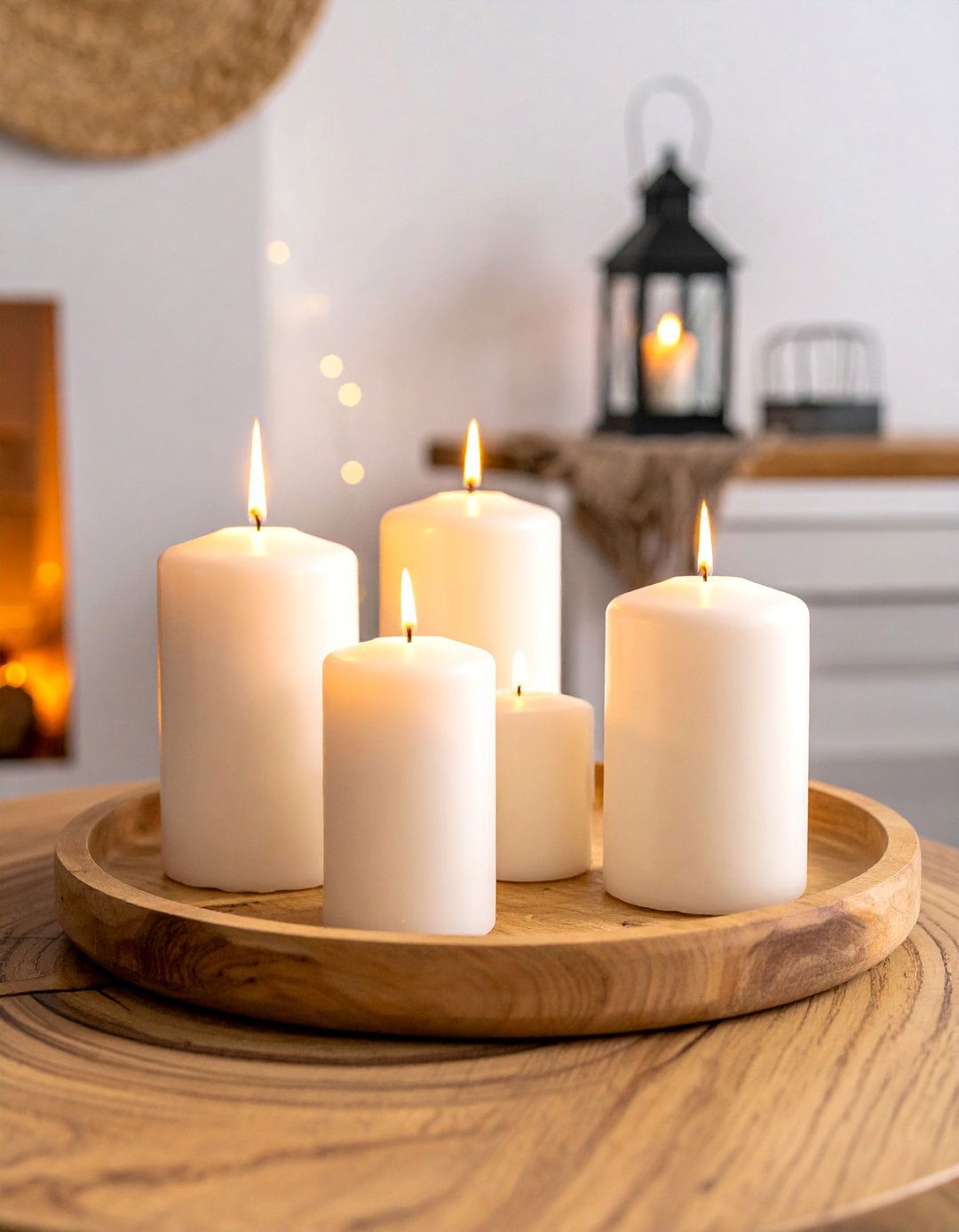
Creating a cozy, hygge-inspired atmosphere heavily relies on soft, warm lighting, making candles and lanterns indispensable decor elements. Group pillar candles of varying heights on a wooden tray on the coffee table or place them on the mantelpiece for a classic, comforting glow. Simple metal or wooden lanterns housing candles can be placed on the floor in a corner or by the hearth to add a rustic, inviting touch. The gentle, flickering light provides a welcome alternative to harsh overhead lighting in the evenings, fostering an intimate and deeply relaxing ambiance perfect for unwinding.
20. A Comfortable Armchair with a Wooden Frame

Every cozy living room needs a dedicated reading nook or a comfortable armchair for relaxation. In a rustic Scandinavian space, select an armchair that features a visible wooden frame made from light oak or ash. The exposed wood structure highlights the craftsmanship and natural material, while the plush cushions upholstered in a soft, neutral fabric like wool or boucle ensure comfort. This combination of a solid, rustic frame with soft, inviting upholstery creates a balanced piece that is both aesthetically pleasing and functional, providing the perfect spot to curl up with a good book and a warm drink.
21. Integrating Black Metal Accents
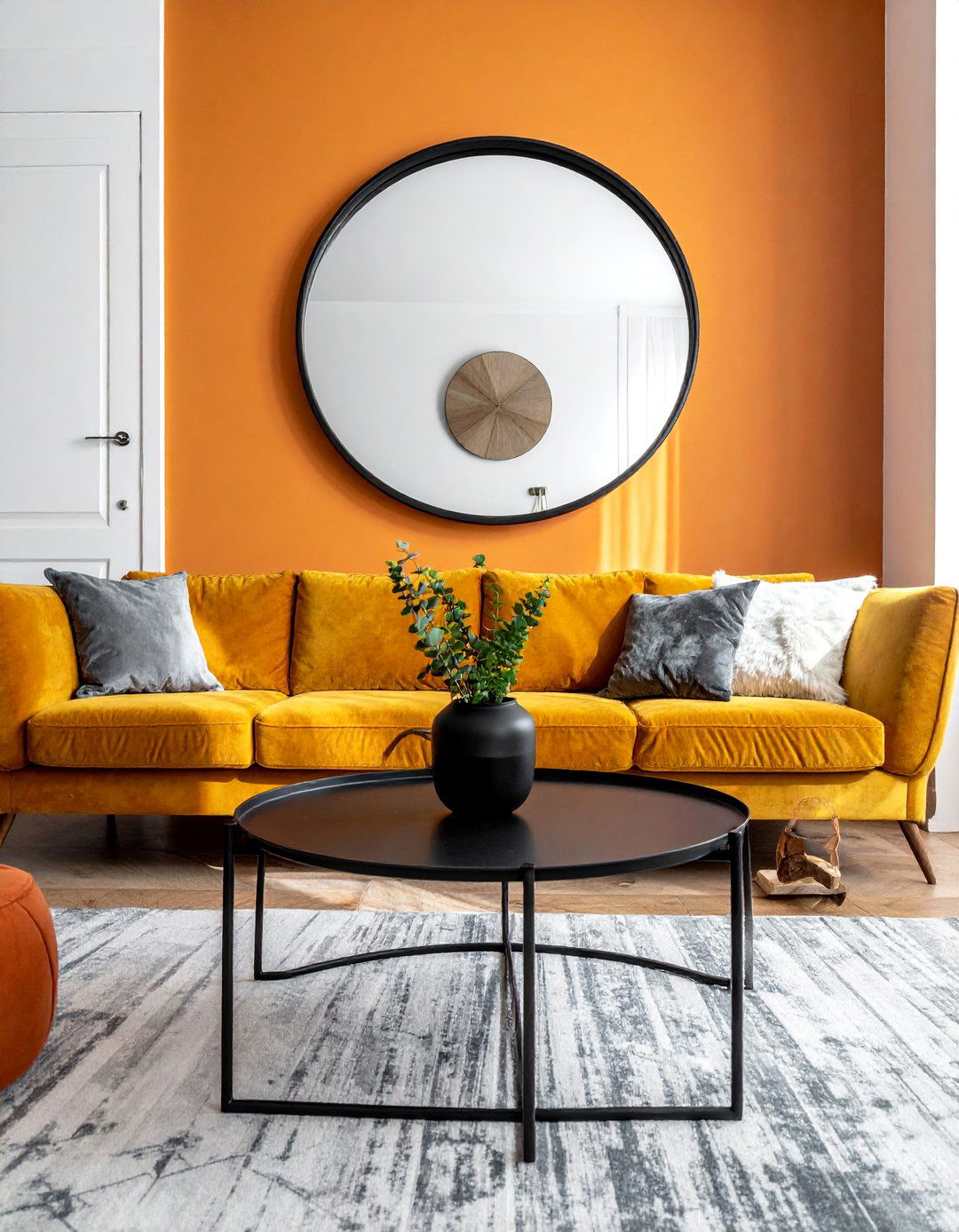
To add a touch of modern contrast and definition to a rustic Scandinavian living room, integrate subtle black metal accents. This can be achieved through the legs of a coffee table, the frame of a mirror, a minimalist floor lamp, or simple picture frames. The sharp, clean lines and dark finish of the black metal provide a striking counterpoint to the soft, warm textures of wood, stone, and natural fabrics. These accents help to ground the space and prevent the neutral palette from feeling flat, adding a hint of industrial edge that complements the overall design without overpowering its serene and cozy nature.
22. A Simplistic Wooden Bench as a Coffee Table Alternative
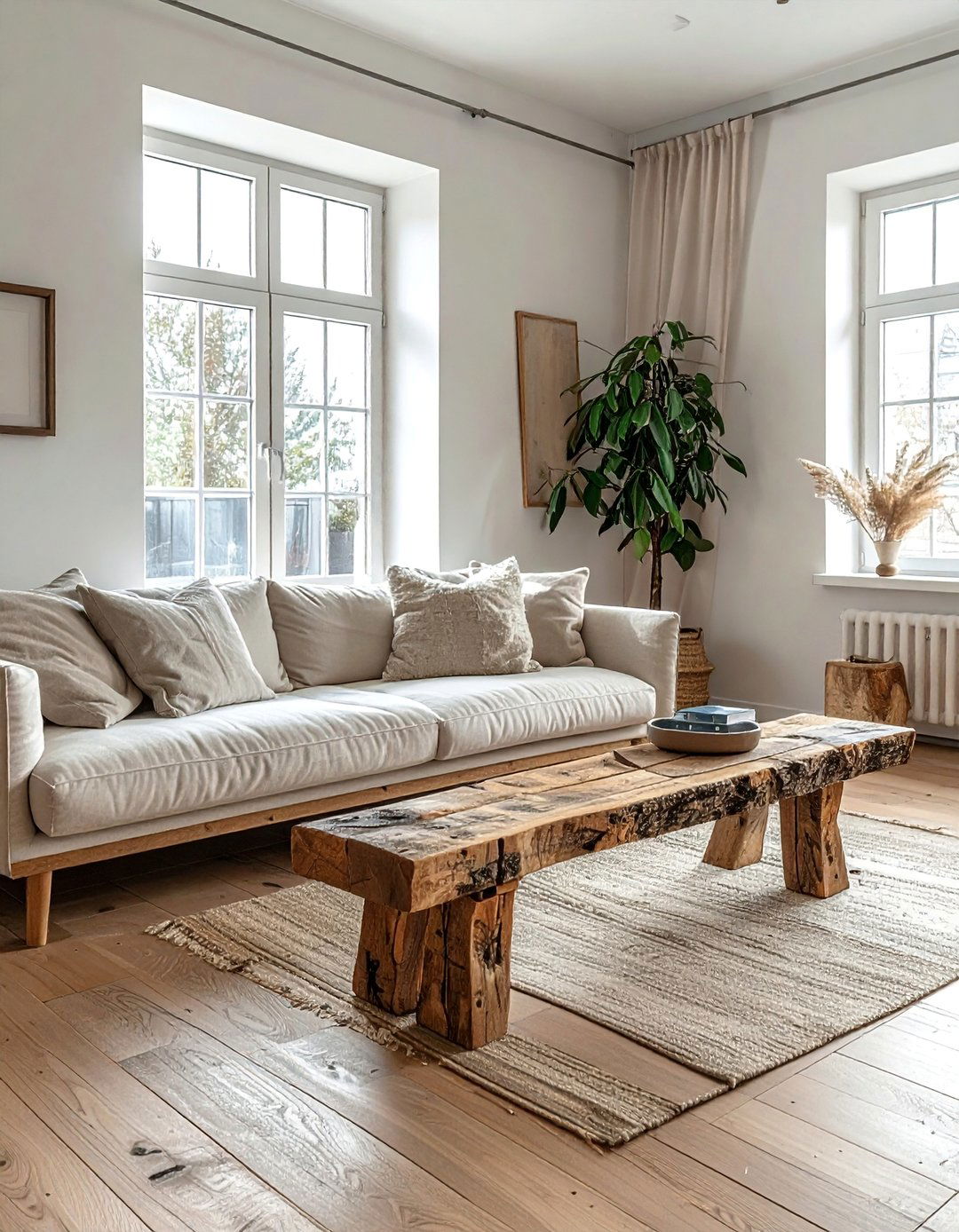
For a unique and minimalist alternative to a traditional coffee table, consider using a simplistic wooden bench. A long, narrow bench made from reclaimed or light-toned wood maintains an open and airy feel in the center of the room, which is especially beneficial in smaller spaces. Its streamlined form aligns perfectly with Scandinavian principles, while the natural wood material provides the necessary rustic warmth and texture. It offers ample surface space for a few curated items like a vase of branches, a couple of books, and a candle, creating a functional and stylish centerpiece that is both unconventional and perfectly on-theme.
23. Decorating with Ceramic and Earthenware Vases
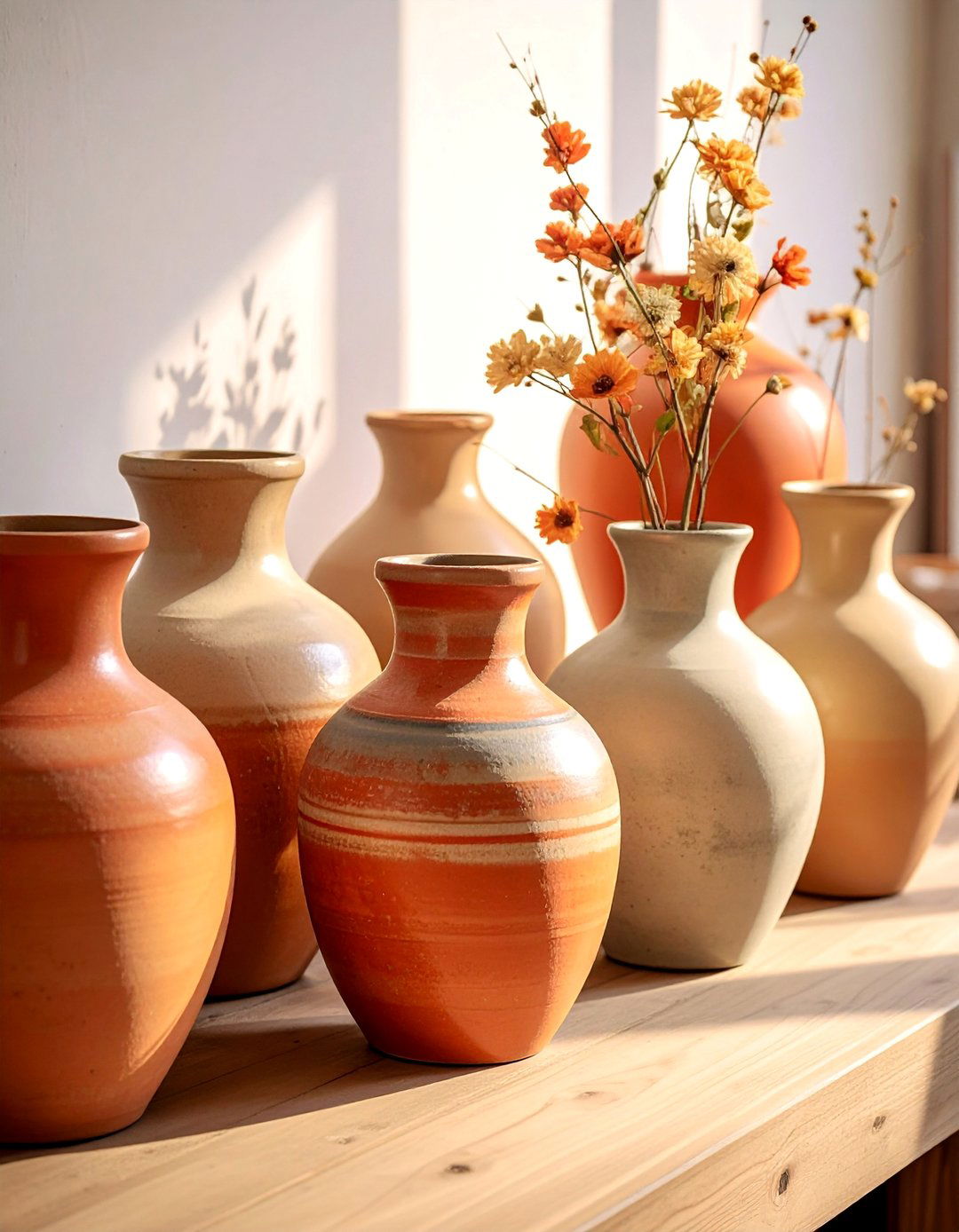
Emphasize the earthy, handcrafted element of rustic design by decorating with ceramic and earthenware vases. Group a collection of vessels in various shapes and sizes on a console table, mantel, or floating shelf. Choose pieces with a matte finish in neutral, earthy tones like terracotta, sand, cream, and charcoal. Their imperfect, handmade quality adds a layer of authenticity and tactile interest to the space. Whether left empty as sculptural objects or filled with dried grasses or fresh branches, these simple yet beautiful accessories reinforce the room’s connection to natural materials and artisanal craftsmanship.
24. A Cozy Window Seat Nook

If your living room has a suitable window, creating a cozy window seat nook can become the most coveted spot in the house. Build a simple bench under the window, topped with a comfortable custom cushion upholstered in a durable, neutral fabric like a gray or oatmeal linen-blend. Pile on an assortment of pillows in different textures and a soft throw blanket to make it an irresistible place for reading or enjoying a cup of tea while looking outside. This feature not only provides extra seating and a prime relaxation spot but also perfectly embodies the hygge spirit of creating small, joyful sanctuaries within the home.
25. A Simple Round Mirror with a Wood Frame
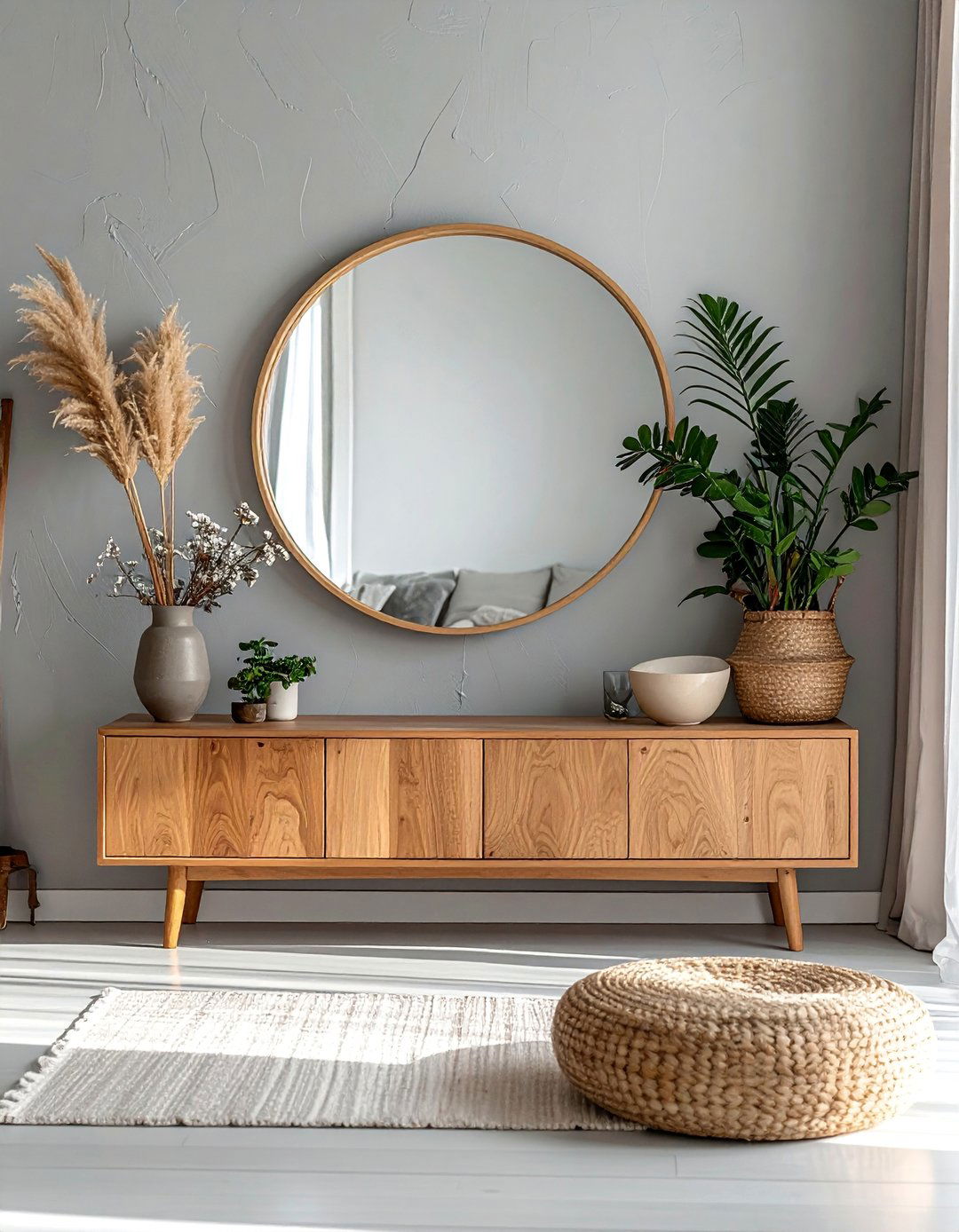
To enhance light and create the illusion of more space, hang a simple round mirror with a wooden frame on a prominent wall. The circular shape offers a soft, organic contrast to the straight lines of furniture and architectural features, while the wood frame ties in with the other natural elements in the room. Placing it opposite a window is a strategic move to reflect natural light and scenic views, making the entire living room feel brighter and more expansive. This functional decor piece adds a touch of understated elegance and practical brightness, aligning seamlessly with both rustic and Scandinavian design sensibilities.
26. A Freestanding Wood-Burning Stove
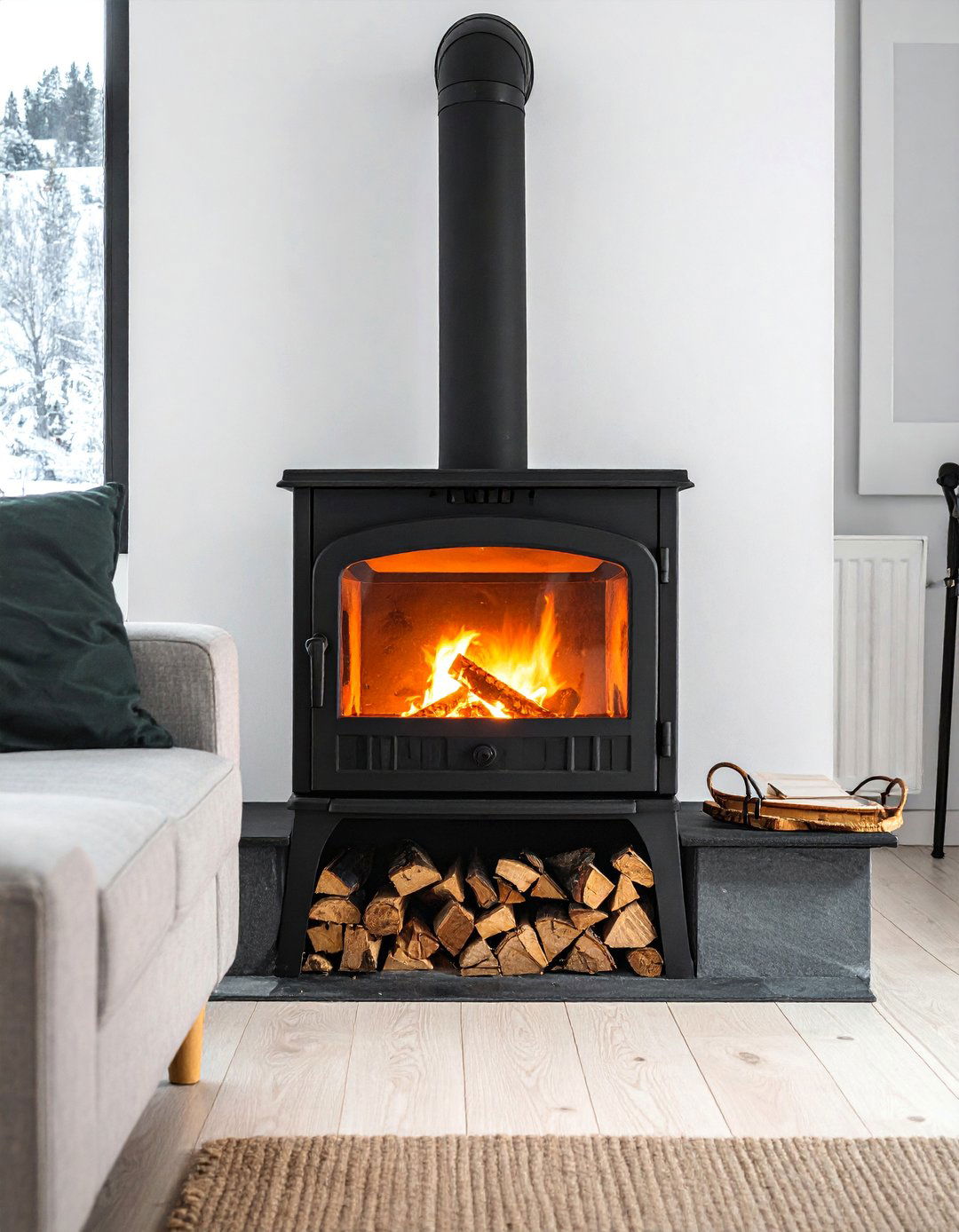
For an alternative to a traditional fireplace that packs a powerful rustic punch, consider a freestanding wood-burning stove. These cast-iron stoves, often in a classic black finish, serve as a highly efficient heat source and a charming focal point. Placed in a corner on a stone or slate hearth, a wood-burning stove creates an undeniably cozy and nostalgic atmosphere. The visual appeal of the crackling fire seen through the glass door, combined with its functional warmth, makes it a perfect addition to a rustic Scandinavian living room, epitomizing the concept of hygge during the colder months.
27. Sheer Linen Curtains

To soften the look of bare windows without blocking precious natural light, hang sheer linen curtains. These lightweight window treatments in a natural, off-white, or beige hue diffuse sunlight beautifully, casting a soft, ethereal glow throughout the living room. The subtle texture of the linen fabric adds a touch of rustic, casual elegance. Hanging them from a simple black or wooden rod high and wide around the window frame can also create the illusion of a larger window and higher ceiling. Sheer curtains provide a sense of privacy while maintaining the bright, airy feel that is essential to the Scandinavian aesthetic.
28. A Low-Profile Media Console in Light Oak
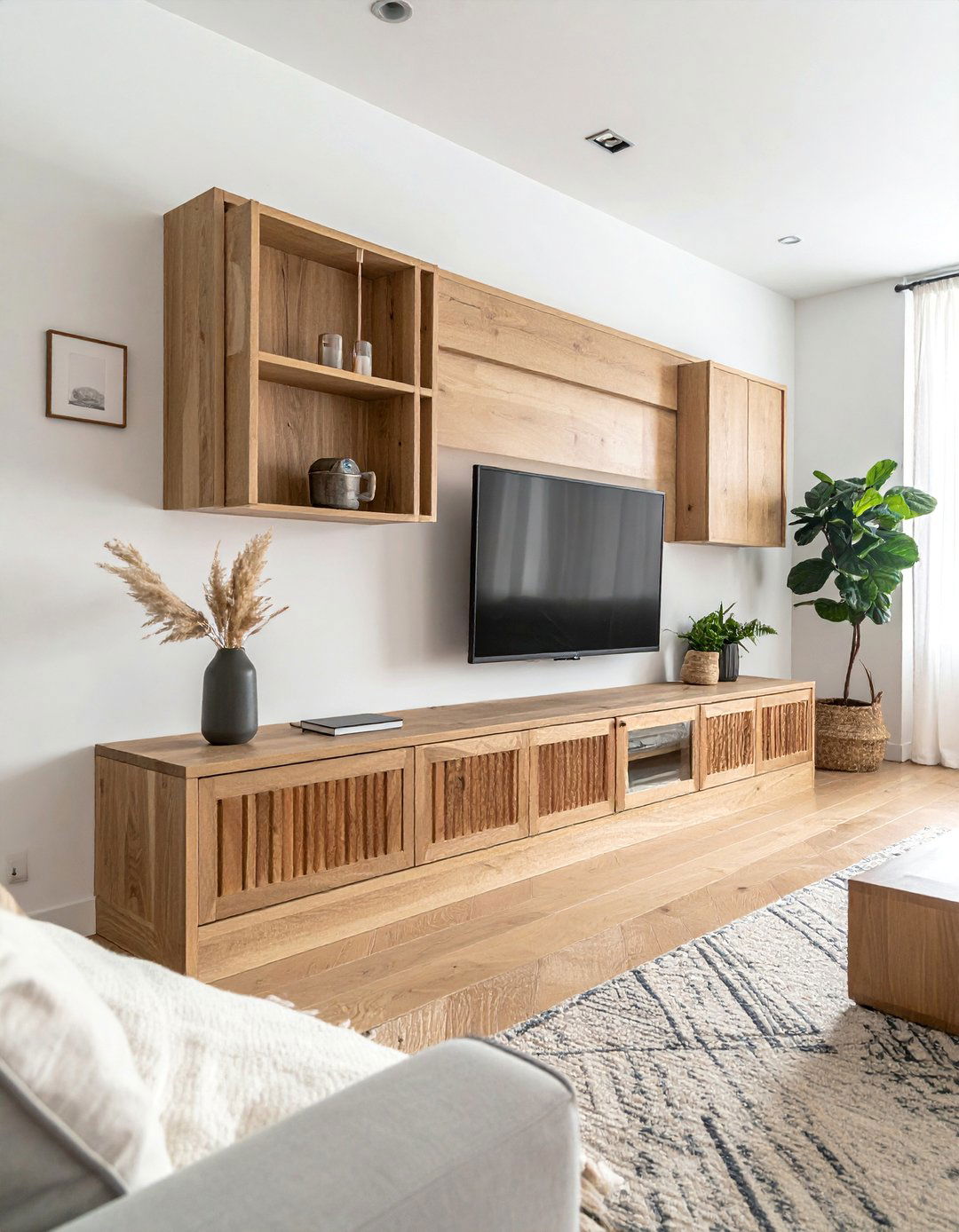
In a modern home, a media console is often a necessity, and choosing the right one is key to maintaining the rustic Scandinavian aesthetic. Opt for a low-profile media console made from light oak or another pale wood. A design with clean, simple lines, minimal hardware, and perhaps some caned or slatted doors will keep the look uncluttered and airy. This piece provides essential storage for electronics and media while its natural wood finish adds warmth and texture, ensuring it integrates seamlessly into the room’s serene and nature-inspired design scheme rather than becoming a jarring technological focal point.
29. A Stack of Books as Decor

Embrace the intellectual and cozy side of hygge by using a stack of books as a simple, meaningful decorative element. Place a neatly arranged pile of hardcover books on the floor next to an armchair, on a low stool, or on the end of a coffee table. Choose books with aesthetically pleasing, neutral-toned spines to maintain the calm color palette. This not only adds a personal, lived-in touch to the space but also suggests a quiet, relaxing pastime. It’s a subtle yet effective way to add character and a sense of comfort to your rustic Scandinavian living room, celebrating the simple joys of life.
30. Using a Natural Fiber Pouf for Extra Seating
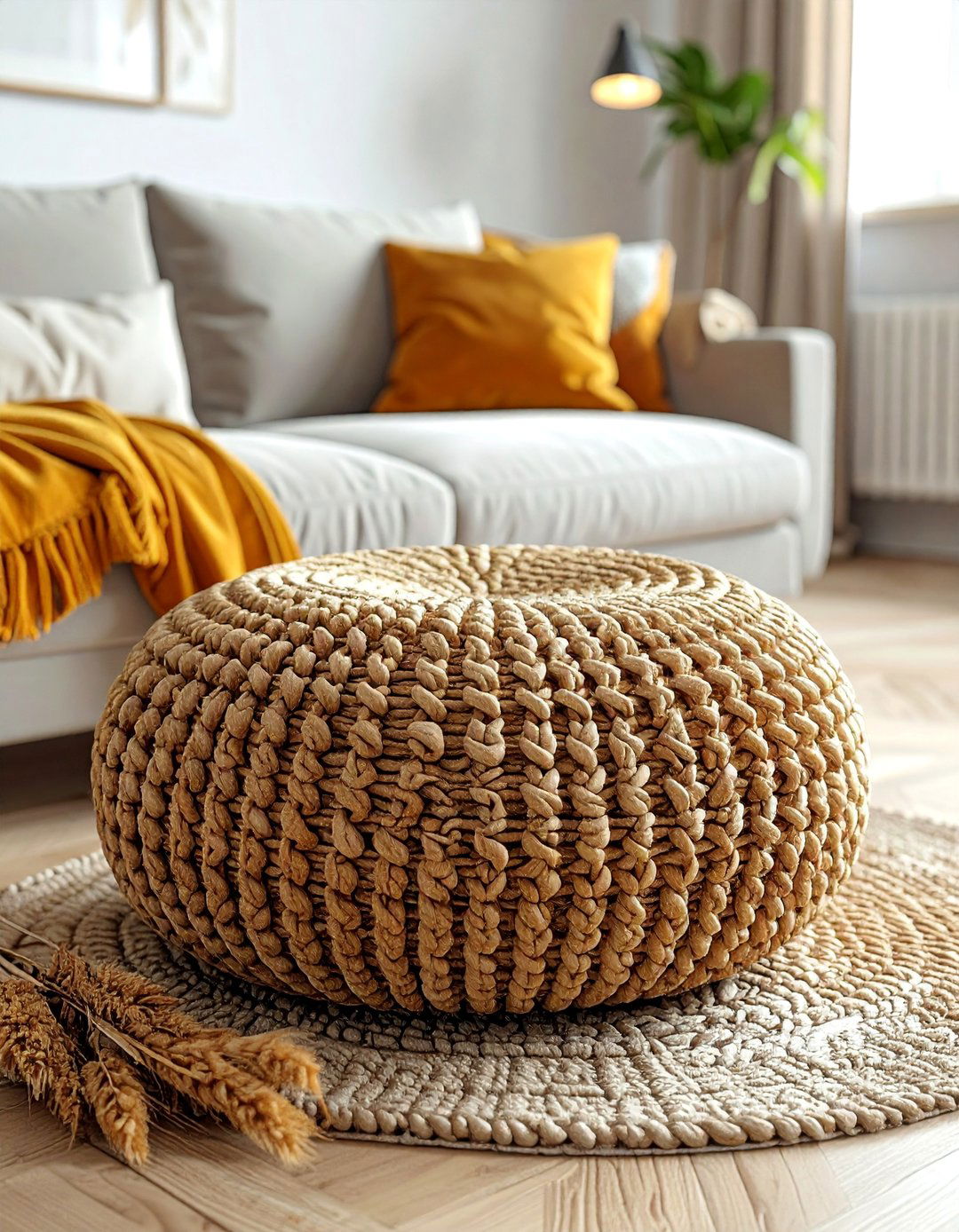
For flexible and casual seating, introduce a natural fiber pouf into your living room. A pouf made from chunky braided jute, wool, or a textured cotton knit adds another layer of cozy texture and an organic, handcrafted feel. It can serve as an extra seat for guests, a comfortable footrest, or even a temporary side table with the addition of a tray. Its small, portable nature means it doesn't add visual bulk to the room, and its earthy material and simple form align perfectly with the relaxed and functional principles of the rustic Scandinavian style.
Conclusion:
Ultimately, creating a rustic Scandinavian living room is about finding harmony between simplicity and nature. By focusing on a neutral color palette, maximizing natural light, and layering organic materials like raw wood, stone, and cozy textiles, you can craft a space that feels both modern and timeless. This design philosophy celebrates uncluttered living without sacrificing warmth or comfort. The result is an inviting, serene sanctuary that perfectly balances minimalist aesthetics with the rugged beauty of the natural world, offering a truly cozy and restorative vibe for your home.


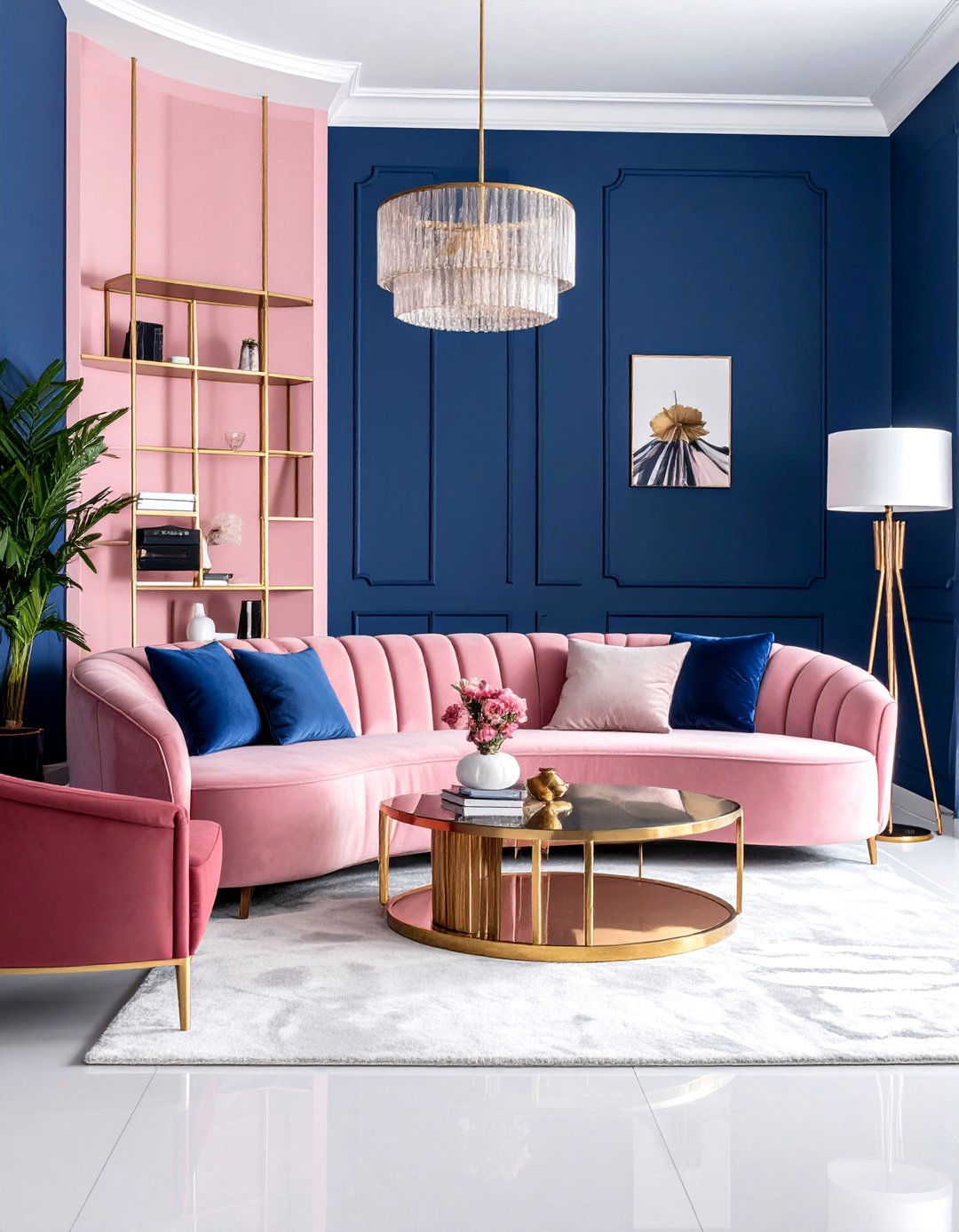
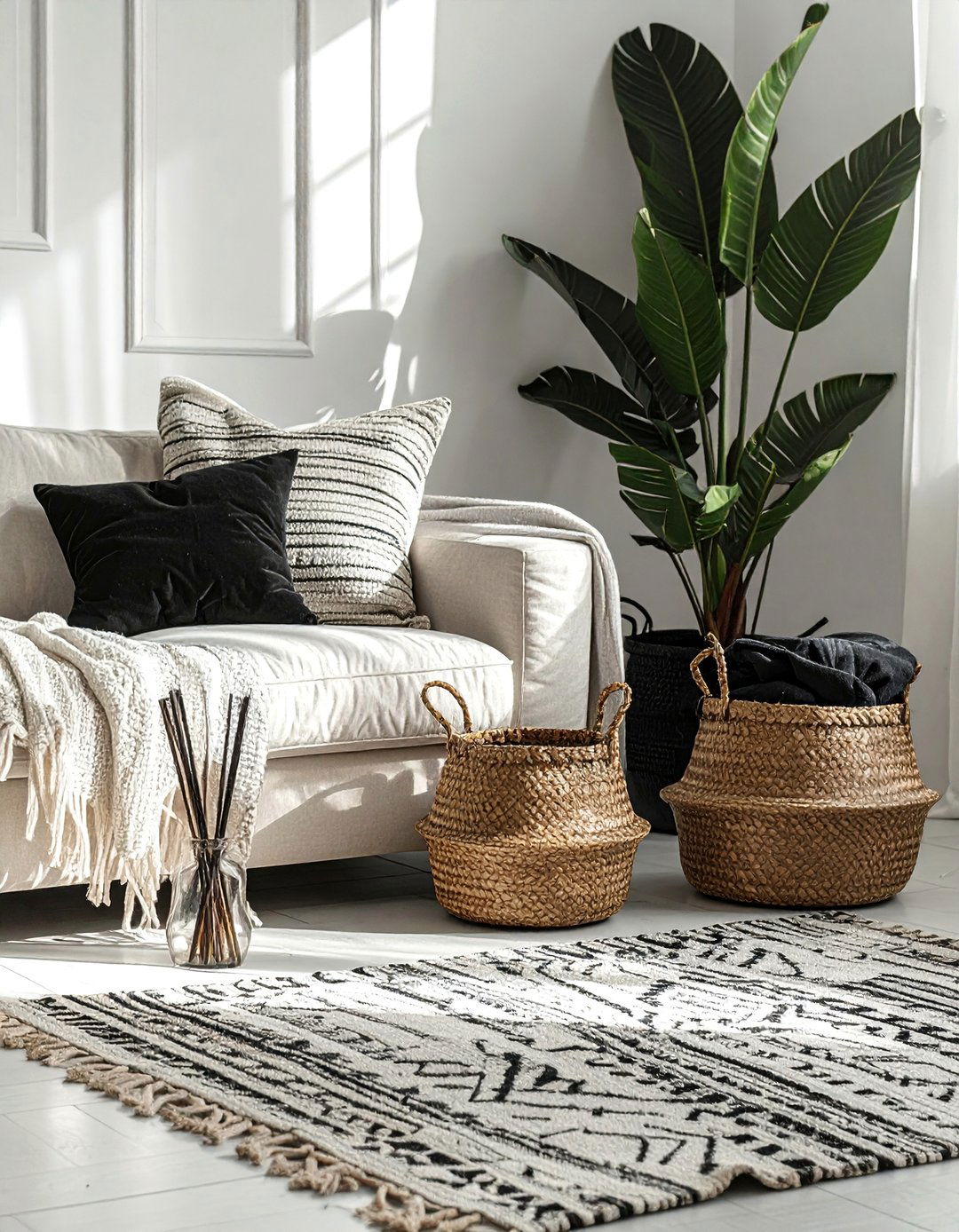
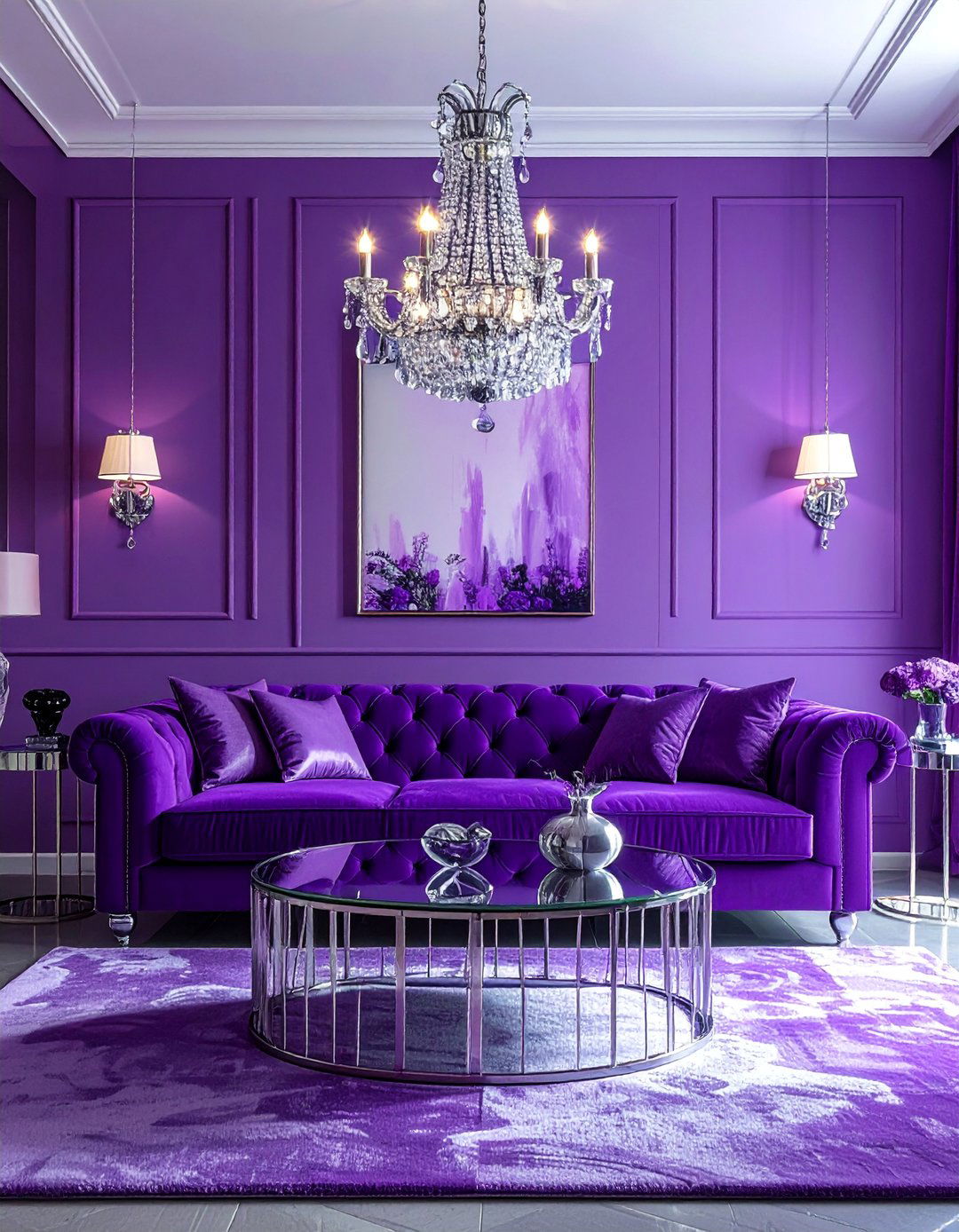

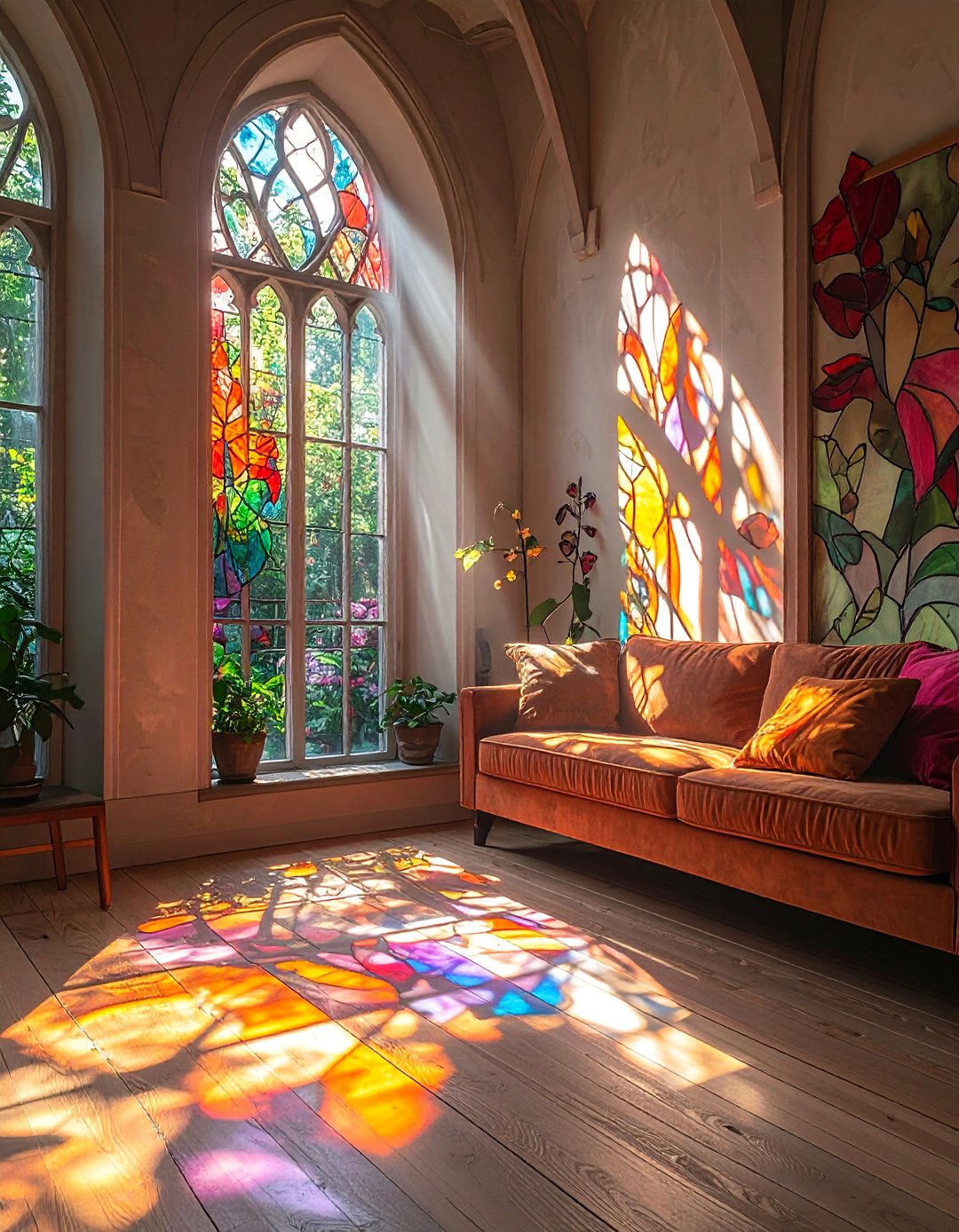

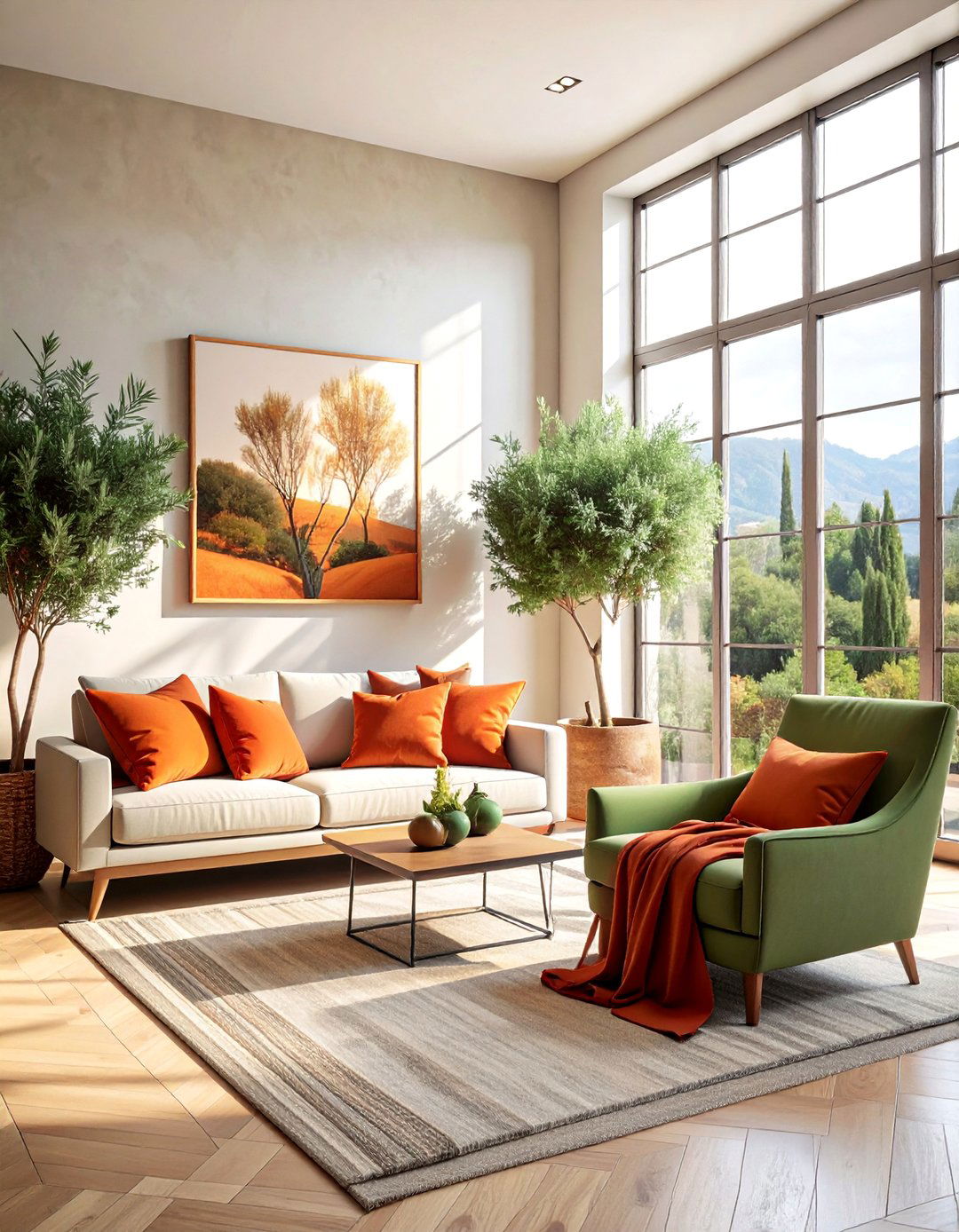
Leave a Reply